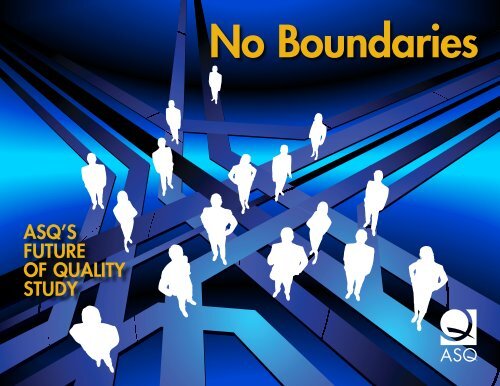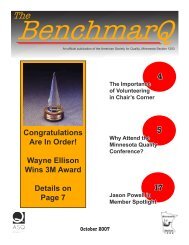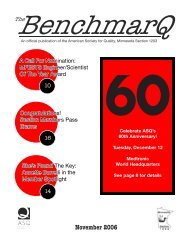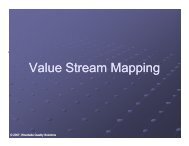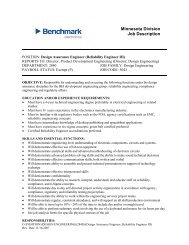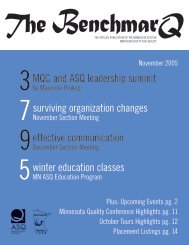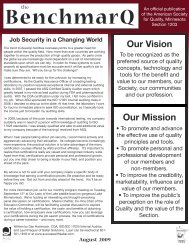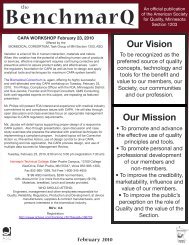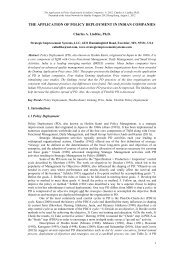ASQ'S Future oF QuAlity Study
ASQ'S Future oF QuAlity Study
ASQ'S Future oF QuAlity Study
- No tags were found...
You also want an ePaper? Increase the reach of your titles
YUMPU automatically turns print PDFs into web optimized ePapers that Google loves.
ASQ’s<strong>Future</strong>of quality<strong>Study</strong>No Boundaries
No one who’s paying attention would argue thatchange is accelerating, and that our lives arepunctuated by disruptive changes no one cananticipate. In the United States, the impact of subprimemortgages comes to mind. The global reach of thesubprime mortgage mess illustrates for all to see justhow far the notion of globalization has progressed.News of natural disasters travels at light speed acrossthe globe, and within minutes we are viewing thea future of constrained resources, where waste is nolonger tolerable, quality knows how to eliminate waste.Those who master the systems of an enterprise mayhold the keys to mastering the systems of a globe.Those who understand how to delve into data formeaning in their organizations may well delve intothe data of world issues and unlock the meaning.Those who bring people together to solve problemsmay tackle problems beyond company boundaries.No BoundariesThe old boundaries havebeen obliterated.2devastation. Global warming, energy issues, and risingfood costs unite all of us in ways no one would havethought of 50 years ago.Those who know and work to master the concepts,techniques, and tools of quality know that qualitycan, and sometimes does, make a difference. Andthat knowledge takes two paths. One path is thejourney traveled by the organizations we work for.The journey to compete, to win in the marketplace, togrow revenue and profit. To meet demanding customerexpectations. To be world-class or risk extinction. And,with rates of discovery and innovation that ply againstever-shorter product life cycles. Today’s victors reapstaggering global rewards. The other path, outsideour organizations, leads to the larger issues ourworld faces. Issues that confront us daily withincreased urgency.Increasingly the two paths cross. Work and the world.The world and work. In the issues that confront theworld, there are opportunities for organizations. InAnd even the definition of a company is changing.Once national, then multinational, now global. Witheach organizational evolution comes evolution ofmanagement, problem solving, and leadership.Global management, global problem solving,and global leadership.Amidst the change, the complexity, and the urgentchallenges there is much to be hopeful for and, if weallow ourselves, even to get excited about. The futureis coming, of that we can be certain. A future of newtechnologies, new consumers, and new challenges toconquer. A boundaryless future of limitless possibilities,unencumbered by familiar conventions and rules ofthumb, but accompanied by no small degree of risk.We have two choices, the first to be swept away bythe sea of change coming our way, the second tonavigate that sea to our advantage. To navigate seaswe’ve never traveled we need new tools. New tools.First clumsy and primitive, then refined and accurate.Such are the tools of futuring.
Futuring, a new word coined by a new profession of futurists, is the art andsometimes science of anticipating the future. As the adage goes, those whoanticipate have advantage over those who don’t. Every culture captures this wisdomin the lessons children are taught. That wisdom is more valuable in a world wherethe future presents itself at ever-faster speeds. And so, we invent and hone newtools. One tool we call upon is a futures study. This particular study concerns thefuture of quality.In an effort to anticipate the future of quality, ASQ undertook its first futures studyin 1995 under the leadership of then ASQ President, David Luther. The value of thestudy was such that ASQ has repeated one every three years since. This study is thefifth in the series, and from them we’ve learned a great deal about the future. Thefirst learning is that try as we might, we are ill-equipped to look very far into thefuture. Change is happening faster than can be imagined. The second learning isthat whatever we know about the future will be overcome by what we can’t knowabout the future. It is certain that the future will surprise us. The third learning isthat “globalization,” however you define it, is the single largest force of changeto reckon with. It is the only force of change that has been constant across all fiveASQ future-of-quality studies.Those three learnings—the rate of change is accelerating; what we can anticipatewill be overcome by what we can’t anticipate; and the immutable reality of ashrinking world—set the context for us all. And now we go back to the wisdom ofthe ages—those who anticipate have advantage over those who don’t.Now, for the use of this study. While many studies attempt to provide answers,this one is aimed at provoking questions. More so, at provoking dialogue. Overthe course of the next three years, ASQ will use this study to provide focus for aseries of “stakeholder dialogues” where we will invite members and others to joinus in conversation about the future of quality. The seven forces, the scenarios, andthe implications are seeds for the conversation. Seeds that provide focus, but notmuch limitation. We will host these conversations all over the world, and fromeach conversation we will capture the wisdom of the participants. Conversation byconversation we will see patterns and themes begin to emerge; from those patternsand themes ASQ’s Board of Directors will consider its strategy in response. Butthat’s just ASQ’s use of the study.We encourage, and in fact will support, organizations that want to use thestudy to ponder the implications for themselves. ASQ will host conversations inorganizations in exchange for the benefit of understanding the future of quality.Company by company, organization by organization, school by school, hospital byhospital, we gather invaluable insights into the issues and challenges organizationslook to address.And then there’s a third, and critically important, use of the study—its use tothe individual. Anyone wondering where careers may go, what skills will be indemand, or where opportunity may lie will find in this study valuable pointersand hints.Paul E. Borawski, CAEASQ Executive Director & Chief Strategic Officer3
The ASQ <strong>Future</strong>s <strong>Study</strong>comprises three major components:4• Identifying the key forces that are mostlikely to shape the future of quality.• Developing alternative scenariosdescribing how these forces might unfold.• Determining implications fororganizations and the quality field,for quality professionals, andultimately for ASQ.
Key ForcesAn expert panel of nearly 100 thought leaders of the quality movement from around the globe,representing every sector of the economy, shared their insights in order to gain a credibleunderstanding of the potential impact of current trends on the future. Through multiple rounds ofconsideration and online dialogue, the panelists arrived eventually at a final-round rank order oftheir choices—the Seven Key Forces shaping the future of quality.1. Globalization dominates the future of quality, as it does so many otheraspects of life. This is the only force that shows up on each of the previousfour ASQ <strong>Future</strong>s Studies. The many facets of globalization create enormousopportunity—and complexity. Organizations once called “international” arenow labeled “global,” suggesting perhaps less of a gravitation toward nationalidentity or country of origin. Globalization is necessitating global suppliernetworks and driving the urgent need to manage global quality platformsacross multiple organizational sites. Variation in approaches is seen as anunnecessary luxury. Standards will continue to rise in importance and use.Organizations also are becoming independent of location and “space” interms of the talent they need to thrive. Consumers, likewise, are becomingglobal in their outlook and habits, aided by the Internet. They consume theproducts and services that best fit their needs, wherever sourced. Globalizationis driving huge new consumer markets, creating both opportunity and concern,which are reflected in forces discussed later. Globalization will drive tradepolicy and impact trading partners in new, unimagined ways. The concepts of“national” and “regional” will have less meaning to everyone in years to come.2. Social Responsibility (SR) roared to the second position in the 2008 rankingsof key forces. It is the first of several forces to reflect the growing concern ofcitizens for the fate of the planet. As a result, organizations are realizing theymust play an important, self-enlightened role as stewards of the planet. Theyacknowledge that being responsible is not only moral, but good business, ifa business is to be sustainable. Recent large-scale examples provide ampleevidence of the impact of irresponsible management. The impact reaches wellbeyond the company owners. Consumers are demanding more knowledgeof company practices. Among the criteria consumers use in making theirbuying decisions, company reputation will assume a more significant place. Asorganizations set SR goals to respond to these demands, they will find they canrely on the concepts, techniques, and tools of quality to deliver on those goals.Ethics, transparency, social behavior, and environment fall into the broaderconsiderations of SR, as does the “triple bottom line” of people, planet,and profit.3. New Dimensions for Quality – If control and improvement are the traditionsof quality, it is clear that a new collection of competencies is needed if qualityis to have much relevance in a world changing at an accelerating rate.Organizations are looking for leadership in creating marketplace innovations;in stimulating new ideas; in managing change at ever-faster rates; and increating value for ever-more sophisticated consumers. Enterprises seek leaderswho value organizational cultures that learn. One futures study panelist wasbrave enough to call these competencies the fundamentals of 21 st centuryquality. Clearly, near-perfect product quality is an assumed requirement, nolonger providing any sustainable differentiation in the marketplace. Whileassumed, perfect quality is not the outcome of chance. Organizations thattake quality for granted will soon learn that lesson. Clearly, innovation withoutquality is a non-starter. The study participants are mindful of the fact that thisforce, or these forces, are at work in the system of the organization, not just inthe products and services of the organization. Chaos and order must learn tolive in the same space, and people systems will be taxed to keep up with thepace of change the marketplace demands. Organizations must master theseabilities or give way to smaller, newer, more agile competitors.4. Aging Population is another force with multiple dimensions both addingto the problem and contributing to its solution. Life spans are increasingeverywhere, and, as economies grow, and the middle class expands,healthcare is available to more people, though not to everyone. An agingpopulation drives economies and organizations to respond to this large marketneed. Historically, the world has exploited the brawn and energy of its most5
6numerous population segment—its youth. Assoon as 2025, the majority of the populationwill be 60-plus. Retirement is an invention of thelast century whose ramifications are being fullyrealized only now in this century. The world neverexpected so many healthy, nonworking citizens,possessing the means to consume. This is themarket opportunity and the crux of a social-systemcrisis in the world’s most developed nations. Thegeneration that inherits these realities will bechallenged to find creative solutions the previousgeneration could not.The aging population poses workplace challengesas well. As aging workers leave the workplace,organizations will be challenged to replace theirknowledge and experience. It may well be that acreative solution entails a return to the workplacefor significant portions of the aging population,allowing them to contribute what they know and toenjoy more productive golden years, while at thesame time generating unplanned tax revenue toalleviate social needs. The seeds of this trend havealready been planted. Retirement may well beredefined, leaving retirement as we know it a relicof 20th-century history.5. Healthcare—or more precisely the demandfor healthcare—is clearly a by-product of thepreceding forces on this list. Globalization isadding staggering numbers of people expectingaccess to healthcare. That growing globalawareness of healthcare need is not alwaysmet with healthcare services provided. And thedemands of an aging population, with means,will conspire to significantly heighten the needand demand for healthcare. Clearly, qualitycan play an important role in taking waste outof the system so that more people can benefit.Neither the wealthy, nor the poor, can afford theincreased societal costs as healthcare consumesan ever-larger share of GDP. Policy makers havetheir hands full with the challenges of equitableaccess. They should not be taxed further byfinancing waste that often equals the actual costof the care provided. Emerging biotechnologyand nanotechnology advances, which hold thepromise of curing disease and further prolonginglife, add to the complexity of the healthcare world.With these fast-developing technologies in thehealthcare mix, completely new quality scienceswill be required.6. Environmental Concerns have not been on thekey forces list for nine years. The strength ofthe return of this force cannot be fully realizedwithout considering related comments on socialresponsibility and the force of climate change(which did not make the short list of key forces). In1999, environmental issues were spoken of as aconcern for the future. It’s clear that in 2008 thatfuture is here. There is urgency now, and concern.There is hope in the demands consumers willmake of producers. There is hope in the growingawareness within organizations of the economicvalue of reducing environmental impact. Thereis hope that the force of globalization will createregulations and standards of accountability bywhich all producers everywhere can be measured.But hope, the research panelists suggest, will notbe enough. Action is needed.Scarcity will drive cost, and cost will drive changedconsumer behavior. Or, so macroeconomicssuggests. This may be another source of hope. Butthere was no hope for the remediation of damagealready done and the fear of the damage ofexplosive consumption the world faces.Again, quality can contribute and affectimprovement. For organizations that want waysto manage their systems, quality provides theconcepts/tools/techniques, and even a standard.For policy makers who welcome new thinking atthe table, the quality movement wonders how to geta seat.7. 21 st Century Technology – The most talked-aboutfeature of current technology is the startling rateof change it is experiencing and its resultingdisruptions and discontinuities. Technology’simpact, while difficult to forecast, is certain tosurprise in ways that disrupt our models for nearlyeverything we think we understand.Some believe that technology will deliver solutionsfor sustainable energy, which will have the addedimpact of altering the political landscape ofthe world. Some believe technology will deliversolutions for fresh water scarcity and global foodshortages. Certainly genetics, biotechnology, andnanotechnology have the potential to shape theworld more radically, and faster, than informationtechnology has. And everyone agrees informationtechnology and the Internet have not finishedchanging everyday life. Who would have everthought a terabyte of storage could be held in yourhand, much less cost less than a day’s wage? Andthat was yesterday.If technology is a driver of change, think ofquality as the navigator. It is difficult to imaginetechnology going anywhere without quality—butnot today’s quality. Therein lie great challenge andopportunity for quality.
Scenarios and Effects on Key ForcesArmed with this expert view of forces shaping the future, ASQ Past President Greg Watsondeveloped four brief alternative scenarios depicting a spectrum of potential future world conditions.One scenario reflects a “utopian” world where the forces of good overcome the forces of “evil” thatcause the degradation of our global condition. Another scenario describes the opposite conditionwhere the forces of “evil” win and humankind does not resolve the issues, concerns, and challengesthat it is facing. This situation is often called a “doomsday scenario.” Between these two limits of thefuture lie two alternatives—a “preferred scenario” and a “business-as-usual scenario.”Global Transformation: Innovation of a Complex SystemThe threat of drastic changes in humankind’s way oflife from negative forces facing the entire world is metwith a ‘rebound’ effect as people stop their constantarguments about what will happen and embrace theneed for aggressive corrective action. The aim of thisaction is to halt and then reverse the negative effectsof those forces that are unpreventable and to seeksolutions to prevent those negative forces of changethat are avoidable. Quality methods (defined intheir broadest sense) are a key change catalyst thatenable humankind to consider new opportunities anddefine action alternatives by focusing the best minds,methods, and means to drive improvement in areasthat threaten the infrastructure of the world (economic,environmental, political, and social). To drive theoutcome of this scenario, technology, finance, andquality methods are the focusing forces that are usedto create and implement a global investment strategythat is able to achieve broad systemic solutions to theworld’s most pressing problems.Notice how the forces for change influence differentdimensions of this scenario:• Globalization – Environmental, political, andsocial issues have been treated as an internationalsystem by a united confederation of the world’sgovernments that controls the global economy.Quality is used to focus on the elimination of waste,fraud, duplication, and bureaucracy and assurea responsible application of resources to facilitateresolution of the most pressing global issues.• Social Responsibility – The need to balance thedichotomy between the have and have-not nationsand to have a more equitable development of theworld is broadly recognized along with acceptanceof social responsibility among the world’s leadingnations. Principles of quality in governance areapplied to all public and private sector institutions.A global standard on social responsibility andcorporate governance and a methodology foreffective self-assessment for governance excellencehave met with broad acceptance.New Dimensions for Quality• – The emphasis of thequality movement shifts to corporate governanceand waste elimination. It concentrates on theresolution of the multi-dimensional problems byfocusing on a broad definition of “total quality” thataddresses all aspects of social systems in both thepublic and private sectors. Quality methods havebeen integrated into the governance excellenceself-assessment process and are accepted as theglobal best practice for daily business analyticsin organizational performance managementUtopianScenario7
8systems in production, service, healthcare, energy,education, transportation, and construction.• Aging Population – All three elements of the agingpopulation crisis have been successfully resolved.While healthcare improvements have extendedthe lifespan expectations, actions for restructuringeconomic conditions have helped to resolve thefiscal impact of this longevity increase. Retirementsystems have been redefined to accommodatethe expanded productive lifespan of people. Asecond emphasis has been the use of informationtechnology methods (such as adaptive learningand artificial intelligence) to capture the knowledgeof the aging population and integrate it into theworld’s technology systems. The ability of an oldergeneration to work productively for longer periodsmeans that they can forsake a purely politicalmotivation, apply their accumulated wisdom, andTable 1Forces of Change From All ASQ <strong>Future</strong>s Studieswork for the greater good of humankind andsociety. They can turn their talents to the restorationand improvement of the world’s urban infrastructuresystems for housing, transportation, energy,communications, water, and sewage.• Healthcare – Genome technology, nanotechnology,and biotechnology merged to create core solutionsfor the longevity of productive human life.Sound quality management practices have beenimplemented in healthcare systems to eliminatewaste, streamline procedures, and assure theconsistent delivery of the “best theoretical care” forthe major ailments affecting humankind. Distributionof care in this system has been assured through a“kiosk” system of diagnostic stations that is linkedthrough information technology for real-timeassessment of ailments and to nanotechnologydelivery systems that provide prescriptive treatments1996 1999 2002 2005 2008Changing values Partnering Quality must deliver GlobalizationGlobalizationbottom-line resultsGlobalization Learning systems Management systems Innovation/creativity/changeSocial responsibilitywill increasingly absorbthe quality functionInformation Adaptability and speed Quality will be OutsourcingNew dimensionsrevolutionof changeeveryone’s jobfor qualityVelocity of change EnvironmentalsustainabilityThe economic case forthe broader applicationof quality will need tobe provedConsumer sophisticationAging populationIncreasedcustomer focusGlobalizationGlobal demand forproducts and serviceswill create a globalwork forceLeadership Knowledge focus Confidence inbusiness leadersand organizationswill declineQuality in new areas Customization Customer expectationsand differentiation will continue to riseChange inShifting demographicsquality itselfValue creationChanges in qualityHealthcareEnvironmental concern21 st century technology“at the point of contact” at the diagnostic station.This healthcare system operates based on anextension of Internet technology as a means toimprove accessibility of the healthcare coverage.• Environmental Concerns – Environmentaldegradation has not only been halted, but levelsof greenhouse gases in the atmosphere havebeen rolled back to the level of 1990. A systemof global pollution sensors has been deployedinto space to observe polluting activities and issuesummary judgments and punitive fines againstthe perpetrators through a system developed touse the Internet technology for enforcement ofglobal “equity initiatives” related to improving theenvironment. Clean energy and pure water havebeen developed and deployed to all areas of theglobe so that deserts now bloom and are productivesources of foodstuffs and the grain needed forbiotechnology energy products. Active research onlong-term solutions to clean the oceans of yearsof accumulated pollutants is under way to assurethat no surprises lurk in the future to once againthreaten the existence of humankind.st• 21 Century Technology – Although the world isbeing depleted of many of its natural resources,focused global investment in technology hasdiscovered the means to apply nanotechnologyto eliminate dependency on fossil fuel as a globalenergy source. Biotechnology breakthroughsincrease the capability of healthcare to manageglobal systemic issues while also developingsolutions for controlled harvesting of new sources offood for feeding the global population. Technologyfor desalinization and purification of water aretransferred from the American space shuttle systemsand made commercially viable on a large scale toresolve the global water distribution problem.
Global Adaptation: Evolution Toward a Synergistic SocietyThe increasing atmospheric hole in the Southern Hemisphere greatly increased global warming andthe subsequent loss of major portions of the Antarctic ice shelf in late 2008. This became a wake-upcall to global leaders to unite for the common good in the cause of preservation of the environment.In the political world, the United Nations decided to expand its emphasis on the principles of qualitygovernance by providing a global quality management program for the 200 national governmentsholding membership. This program was developed to decrease waste, fraud, and abuse in publicfunded programs and to establish a global “transcendental culture” based on proven principles ofquality management. More than half of the governments have elected to participate in the program;a few major government holdouts have limited the effectiveness of the whole program. In summary,many of the dimensions of the social and environmental threats that were perceived in 2008 havebeen halted, but in many cases, not before there has been significant damage. Focus on repairingsocial, fiscal, and environmental infrastructures through evolving global improvement programs is amajor role of the World Quality Alliance.PreferredScenario9
in the global Quality Body of Knowledge (QBOK ® ).Quality systems, measures, and tools have beenembedded in most software systems and evaluatedby a global council of “quality guardians.” Whilemuch has been done, much still needs to beaccomplished. Most efforts are required in the areaof implementation, rather than development.10Notice how the forces for change influence differentdimensions of this scenario:• Globalization – Recognition of the need forcollaboration to address the systemic problemsof the world has caused a rapid consolidation ofthree forces for change: 21 st century technology,new dimensions in quality improvement, and socialresponsibility combined with focused use of thefiscal resources of the world. These forces arein the process of being coordinated to addressthe chronic problems related to the environment,healthcare, and aging.• Social Responsibility – Progress on the front ofsocial responsibility includes a new standardfor self-assessment of “quadruple bottom-lineinitiatives” using the perspective established for allkey stakeholder communities. In addition, standardorganizational measures have been developed forall major categories of public and private sectorenterprises and these have also been promulgatedas a voluntary international quality standard.Finally, a global quality prize for excellence ingovernance has been developed by the WorldQuality Alliance as a means to focus organizationalleaders from all sectors in their responsibilityfor good governance and to encourage thedevelopment of role models of excellence. Sinceall of these efforts rely on voluntary compliance,the major weakness is no longer in definition ofthe approach, but in its effective deployment anddemonstration of subsequent related results.• New Dimensions for Quality – A coherentquality methodology has evolved that has beendemonstrated to be applicable in both traditionaland non-traditional fields. A comprehensivesystems approach to quality, as a further extensionof the Lean Six Sigma methodologies, has beendeveloped to improve the world; however,resistance to its universal adoption as a globalbest practice is prevalent in many areas becausethey resist the “industrialization” of application totheir social systems. Much effort has been madeto demonstrate the value of this program throughfocused improvement projects at the national level,with technology transfer to all other nations, andnew knowledge gained in such projects is included• Aging Population – One area of difficulty in drivingimprovement is the acceptance of senior citizensof a continuing productive role in society. Manyfeel that they are entitled to the retirement that waspromised to them and that any reduction in theirbenefit expectations is tantamount to deceit andshows lack of faith by the world’s politicians. Sincethe majority of the world’s population is above 60,and they tend to vote as a bloc on aging issues,not much progress has been made in redefiningsocial benefit programs for elderly citizens. Thereare successes in other areas: transitioning retireesinto “second or third careers” has long been thepractice in Japanese management; preserving theknowledge base of retired workers through criticalincident interviews using artificial intelligencediagnostics to reveal key workers’ knowledge; anddeveloping communities of practice where seniorcitizens mentor young leaders and workers in returnfor “credits” redeemable for the education of theirchildren or grandchildren.Healthcare• – Quality application for the healthcarecommunity has been one of the greatest successesin this scenario. Standard procedures for mostmajor illnesses have been developed, professionallyreviewed, and disseminated as best practices.Movement of standard practices to a continuingachievement of excellence is accomplished bycomparing performance for all of these proceduresagainst the “theoretical best” capability for care.Elimination of waste in the healthcare system hasbeen credited to the wide adaptation of Lean SixSigma methodologies as used in service industriesand developed for transfer into healthcare
organizations. Healthcare has caught up tomanufacturing in terms of its acceptance of qualitypractices and methods. While good healthcareis now universally available in most developednations, recurring problems with access to highquality care is not universal in the developing world.• Environmental Concerns – Reforestation andselective forestry harvesting methods that weredeveloped in Scandinavia have been distributedas a global best practice, and the world hasnow experienced a reduction in the carbon cyclebecause of the massive increase in planted trees(10 billion trees planted in 10 years). While thisprogram has helped to rollback carbon emissionproblems, it has also allowed space for a moreenlightened approach to the needs of the world’sdeveloping nations to exploit their natural resourcesin order to develop a strong economic base. Whileglobal warming was not prevented, the effect hasbeen to halt growth in the collapse of the Articand Antarctic ice caps. This success has preventedpotential major catastrophes and the effect of risingwater on polluting coastal lands and ocean foodbanks. A major international effort continues tomanage the environment better through technologyinvestment in research fields that have promise forrapid gains in the greenhouse gas system in theatmosphere. The world has set new aggressivegoals for balancing the environment by focusingfinancial and technological efforts on the fullspectrum of systemic environmental issues facingthe whole world: making solar and wind energyeconomical; providing useful energy from fusion;developing carbon sequestration methods; andharnessing the nitrogen and hydrogen cycles tosustain broad applications of fuel cell technology forenergy storage.21 •stCentury Technology – Increased technologyinvestments have been made in alternativefuels, fuel cell technology, and power sourcesfrom non-fossil fuels. A global investmentprogram developed by a consortium of majortrans-national corporations collaborates acrossEuropean, American, and Asian researchand technology organizations. The researchagenda concentrates on issues related to waterpurification, food technology, biotechnology,non-conventional power sources, and fuelefficientmass transportation systems. As a steptoward enlightened social responsibility, thisresearch group invests half of the profit fromcommercialization of these enterprisesto elimination of the debt burden of developingnations and an equitable compensationto countries that elect not to exploit theirnatural resources in ways that lead toenvironmental degradation.11
12Business-as-UsualScenarioGlobal Stagnation:The Halt of Human ProgressThe promise of technology has not been fullyachieved, and the optimistic feeling that technologycan resolve all of society’s problems has dissipated.The rate of progress in technological advances overthe second half of the last century has deceleratedand society has not been able to absorb newtechnologies. The evidence of technological slowdownexists in several advanced technology applications:nanotechnology is limited by measurement systemcapability; artificial intelligence is limited by the lackof decision algorithms to define new learning patterns;and telecommunications advances are limited bythe burden of maintaining legacy systems. Sincetechnology could not be diffused into appropriatesocial applications at ever-increasing rates, adestructive tension has evolved: Potential advances forthe benefit of humankind cannot be deployed due tothe inability of humankind to manage discontinuous,disruptive change. In short, people have come tofear the impact of new technologies in their personallives. This trend began with genetic biotechnologyapplications in agriculture during the mid-1990s andexpanded to include all innovations that confrontpeople’s lives with major change. Other observationsmay be made about this scenario: First, there has beena systematic weakening of the United States’ politicaleconomicpower in the world and a concurrentprogressive growth and expansion of the politicaleconomicpower of developing nations (most notablyChina and India), which have come to dominate theworld’s economy. Additionally, strength in a unifiedLatin American market has occurred. The AmazonPact, Association of Caribbean States, MERCOSUR,and NAFTA trade agreements consolidated toencompass the Caribbean, Central American, SouthAmerican, and North American states in a moreviable Free Trade Area of the Americas (FTAA)agreement with inclusion of the United States andCanada as equal partners in a democratic tradingunion. Following the inclusion of Russia and all thecentral European states, the European Union (EU)increased its political-economic influence. However,EU market growth came not from innovation, but as anatural consequence of expanded membership and thefiscal realignment based on a continuing weakenedAmerican dollar. The impact of the shift into theseregional trading centers has fundamentally changedthe global marketplace, forming silos representingclusters of nations that have created a modern form ofself-preserving isolationism.Notice how the forces for change influence differentdimensions of this scenario:• Globalization – Although the world is faced by animperative to work together on global solutions forsystemic problems, regional alliances prove to bemore compatible with national politics. Growingdistrust of “Western” motives causes isolation ofAfrica and encourages development of strong tradeconfederations among Far East, Americas, Europe,and Middle East nations. Thus, the world’s fiscalresources are fractured and are not concentratedon solving critical problems such as healthcare,environment, aging, and social responsibility.Suspicion and skepticism about motives ofthe differing regional alliances causes lack ofacceptance of the technological advances andthwarts the embrace of a ‘transcendental’ qualityphilosophy or set of methodologies for problemsolving and innovation. The world is fractured andall the king’s horses and men can’t seem to put itback together again!• Social Responsibility – Initial steps have been takento improve corporate governance, but concerns aboutregional competitiveness inhibit full transparency andopenness of activity. Social responsibility operatesreasonably well within regional alliances, but tradeboundaries and growing political strength of theregional groups divides the world in the same waythat national boundaries had in the past.
• New Dimensions for Quality – Qualityprofessionals have managed to develop a set ofexpanded tools and methods that provide improvedcapability to address all critical issues facing theworld, but these methods are met with exceptionalresistance and are considered “American” methodsthat won’t work across cultural boundaries.Rejection of philosophies and methods based ontheir region of origin and a not-invented-heresyndrome exist in many regions. Thus, while qualitycan provide answers, it is inhibited from doingso because quality has yet to become a part ofa transcendental world culture that bridges local,national, and regional boundaries.• Aging Population – Treatment of the agingproblems slips in priority, as resources are notavailable to address the issues and senior citizensare left to fend for themselves based solely on theirpersonal investments. Regions care for the agingcitizens based on the traditions of the dominantregional culture; global solutions are not availableto deal with these issues. Some regions developmeans for senior citizens to make meaningfulcontributions to society, others provide them withfamily-based care, and still others view them as aburden to be cast off into an asylum at the end oftheir productive days.• Healthcare – Managed healthcare is still notavailable universally, and the best medicaltreatment is available only at high prices for thosewho can afford it. While there are many advancesin the capability of healthcare services, availabilityof these solutions is limited and varies greatlyacross the global regions.• Environmental Concerns – Environmentaldegradation is still occurring; however, its rateof change has been arrested and a reasonablepossibility exists for neutralization of the collapsewithin 10 years. The biggest hindrance toaddressing worldwide environmental systemdegradation is the conflict between tradegroups that equate access to power, ability toexploit natural resources, and need to improvetransportation systems with their right to economicself-determination. The emerging economies ofthese nations maintain an entitlement to thesedevelopments, as they are the fuel for economicgrowth to assure the well-being and quality of lifefor their people. Compromise between developednations and developing nations has not beenpossible; the developing nations see compromiseas a ploy by the developed nations to maintaintheir superior position.21 •stCentury Technology – The potential contributionof technology for creating a better global lifestyleand resolving social, political, and economic issueshas been severely dampened by a global backlashagainst broad-scale adaptation of all things new.The major rays of technological enlightenmenthave been the acceptance of a few technologies forcontrolling the carbon and nitrogen balance in theatmosphere and a broad acceptance of energyefficientand alternative-fuel vehicles.13
global resources, have-not nations combine forceswith major developing nations to fight a militarybattle against North America and Europe over accessto and consumption of resources. As a result of thiswarfare, social systems implode. There is a returnto social conditions that resemble the Stone Age asglobal transportation, mass communication,power generation, and political systems havebeen destroyed.Notice how the forces for change influence differentdimensions of this scenario:• Globalization – The world loses its globalperspective, as national and tribal interestsdominate the agenda of local governments anddisorder prevails internationally.• Social Responsibility – There is a total breakdownin global social responsibility as each nation seeksto do what is best for its own constituency andfails to generate a common bond that connects allhumankind. The strong dominate the weak andthe only rule that seems to operate well is that“might makes right.” Principles of self-preservationoverwhelm and replace an emphasis on the“quadruple bottom line”—the environment hascollapsed, thereby destroying the financial structureand leaving the social and cultural elements ascauses of friction and rallying points for warfare.• New Dimensions for Quality – Quality as apositive global force has died along with the restof humankind’s socializing and unifying structures.However, one emphasis of quality practices andmethods remains—application of quality methodsfor the effective use of military operations to subjectthe world to a power-dominated dictatorship.• Aging Population – The aging population ceases tobe an issue as famine, drought, war, and pestilencecreate massive genocide conditions throughout theworld. The youth and weaker aged populations arefirst to feel the brunt of these conditions.• Healthcare – The healthcare system is strappedfinancially and in its capability to serve in the faceof social collapse. People are unable to correct thewaste in the healthcare system; the degradingof all global social systems makes servicein the healthcare system even more wastefuland inefficient.• Environmental Concerns – While the environmentremains a big concern, the focus is one ofvictimization—people wait to see how weatherwill affect them next as climatic conditionsdictate the quality of daily life.21 •stCentury Technology – Fiscal limitations of theeconomy have caused technology to revert to a“tinker’s trade” rather than a systematic, scientificprogram of research. As a result, inventionsoccur, but their broad-scale acceptance and useis impossible, as the world has reverted to aneconomy based on barter resembling a MiddleAges craft-based culture instead of an innovationdrivenmass-production system.15
18Insights From the PanelistsThere were literally hundreds of insights offered by thepanelists. Here is a representative sampling to furtherfuel your thinking.Implications for Quality1.2.3.4.5.6.Clearly quality is being called outside theboundaries of an organization; first by globalsupplier networks, and then to larger socialconcerns such as healthcare, environment, andsocial responsibility. Cultures will shape qualityby way of consumer expectations, consumerbehavior, and work cultures.That quality has changed or was forced to changeis a very debatable issue.Control and improvement methodologies will needto evolve for ever-shorter production cycles.Get ready for quality to be defined in new placesand in new ways.Global standards will help with global platformsand solutions.With the Internet reaching everywhere, quality willknow no national boundaries.“The future success of organizationsdevoted to enhancing quality will dependon their degree of commitment toencouraging modern statistical practices.”– J. Stuart HunterPrinceton UniversityASQ Honorary Member7.8.9.The notion of business success will broadenbeyond profit to include the environmentand society and intangible dimensionsof management.Global perspectives are emerging as the context,and scope, of problem solving.The knowledge and ability to apply the toolsof quality continue to be drawn out of theprofession and into the hands of everyone inthe organization.10. Measuring waste and managing its reductionwill continue to focus quality on the cost side ofthe equation. Quality will need to work extrahard to balance its ability to contribute to thetop line—revenue. Understanding customerneeds, designing for quality, and speed tomarket are at risk, as is quality’s contributionto enterprise management.11. Change and innovation are as much attributesof quality and how we manage as they areof products, processes, and services that areproduced and delivered.12. Finding ways to take waste out of healthcare willcontinue to increase in importance with morepeople deserving access to healthcare along withthe health complexities of long lives.13. Healthcare could benefit from expanding its usesof traditional quality tools.14. Emerging technologies will give rise to newquality disciplines.15. The benefits of quality will be applied to an everlargershare of the economy.16. Social responsibility will demand that ethics andintegrity become system managed.17. To increase its impact, quality must find its wayinto educational systems so graduates enter thework force equipped to advance quality practicerather than stumble onto it.18. Quality must become comfortable with chaos andcontrol coexisting.19. As quality moves into areas less tangible thanmanufactured goods, it will increasingly becomean issue of culture; a “quality mind-set” is needed.20. The quality of data as the product of myriadsensors producing time series composed ofmultivariate measurements in varying dimensionsis often spatially located. This plethora of datawill serve only to pollute clear thinking andrational decision making if it is poorly designed,managed, and analyzed. The theory and practiceof statistics devoted to these new data sources isbeginning to surface.21. There are never better times for quality than timesof crisis. This is such a time.22. The forces taken out of context as driversunrelated to each other offer a weak appreciationof reality. Indeed the forces create their ownsystem of interactions, which understood together,offer more valuable insights about the future. Thisis systems thinking.23. The combination of forces may have differentconcentrations in different regions, and differentmarket segments adding more complexity toorganizations in search of success.24. Quality must align with sustainable results.Implications for Organizations1.2.Consumer knowledge of SR will shape consumerbuying preferences; organizations will need morethan SR marketing to garner consumer favor. Atthe same time, a definition for SR is still a movingtarget and the benefits and trade-offs are notbroadly understood.Changing workplace demographics will demandcreative new employment practices particularly indeveloped nations with shrinking populations.
“The story of three masons is widely known in the field of quality motivation. On beingasked what they are doing, the first mason replied, ‘I am a mason,’ while the secondmason said, ‘I am working for €15 an hour.’ The third mason gave the following answer:‘I am building a cathedral which will stand here for many years and serve as a spiritualplace of rest.’ Furthermore, the answer of the third mason concerns the quality, whichis more intrinsic and can be deployed to more detailed items. Quality is the importantelement of human satisfiers. Investigating them more deeply and specifically is undoubtedlythe key to unlocking the secret of human motivation. This problem will become more andmore important in the coming affluent 21st century.”3.4.5.6.7.Organizations will increasingly look to globalsystem approaches that include supplier networksto manage their performance.As finding knowledge becomes more complexand difficult, productivity is reduced. Neworganization designs are needed to cope withthis reality.Quality culture (often discussed by qualityexecutives) will take on more importance asglobal organizations look to create consistentperformance outcomes across many cultures.Customer expectations today demand quality, butquality of product, service, and every touch pointis not enough unless it is met with speed, agility,and accuracy.Near-perfect quality has become an assumptionin the marketplace.8.9.– Yoshio KondoKyoto UniversityASQ Honorary MemberThe importance of standards will grow inmanaging global enterprises (as well as trade)as variation in approaches that serve no purposeor value to outcomes will be seen as waste andsubject to management.Monocultural directive approaches will yield tomulticulturally-optimized system solutions.10. New measurement and inspection techniques willbe needed for nano and bio applications.11. Quality standards will vary to suit the values andcustomers of the targeted market and its uniquesociety; simultaneously, the sub-cultures of eachsociety will globally seek products and servicesmeeting their unique quality standards.12. New standards for quality governance arebeing demanded to protect the future interestsof all stakeholders.13. Related to changing workplace demographics,employers should expect more contractemployees and consultants. New motivation skillswill be needed as well as new learning aboutsatisfaction and loyalty.14. Today’s middle-aged “boomers” will give way toa smaller youth market.15. High levels of product quality will become anexpected requirement.16. Globalization will drive ever-faster changesin customer requirements, and ever-greatermarketplace complexity, requiring new forms ofleadership and new ways of practicing quality.17. Revitalization of use of basic quality principlesand tools will be applied to new complexproblems in order to realize the unlimited powerof people’s creativity.18. Organizations must prepare for change-orientedcultures and values that support quality inthis climate.19. Sustainability will become as much a concernof quality management as product quality oncewas. Waste elimination.20. Quality’s contribution to “foreseeable” results—new product introductions, R&D payback results,better sooner.21. We’ll see an increase in moving from qualityof product to quality of management andthe organization.19
20Implications for the Profession1.2.3.4.5.6.7.Get ready for increased multi-cultural worksettings, and for approaches that are openenough to benefit from cultural differences. It’spossible that standards will need to have culturalflexibility built in to account for differences inattitudes and approaches to work.The traditional quality professional’s skills of controland improvement need to expand to includeinnovation, creative change, value creation,systems thinking, and execution. New concepts,approaches, methods, skills, and expertise.As SR enters the serious domain of organizationalgoals, organizations will look to professionalswho can turn their SR intent into measured results.This has long been the domain of the qualityprofessionals, who may now find a new careeravenue for their knowledge and abilities.As quality finds ever-broader application insociety, there will be two application fronts: a)the leading edge of technical applications byadvanced organizations that will evolve andcontribute to new generations of quality, andb) a second front of simplified quality makingits application more reachable for less technicalsectors of the economy.Begin expanding the traditional measures ofperformance to include social implications inbalanced scorecards.The systems approaches the quality professionhas evolved through ISO 9000 and othermanagement system standards will be valuedby organizations looking to bring quality,environment, and SR into a holisticmanagement system.Get ready to understand a global world,differences in culture, uses of words, humor….8.9.Innovations in quality are apt to come fromany culture. Best performing organizationswill learn how to balance standardization andimprovement in multicultural synthesis rather thanby monocultural directive.New technologies and smaller products willdemand new approaches to quality, includingmeasurement and inspection technologies.10. The opportunity for quality is expanding ashumanity’s view of itself and its world expands.The profession’s contribution is also expandingbeyond the traditional definition of the enterpriseto problems that are global in scope and benefit.11. How can quality move from better products toa better world in which to live? Be prepared forworkplaces that are creative enough to retainthe experience and knowledge of an aging workforce in a workplace managed and led by 21 stcentury generations.12. The emergence of new technologies will giverise to new quality tools and techniques for theprofession to learn, master, and apply.13. Quality professionals will have to be more awareof international issues. Dealing with suppliers,colleagues, and customers from all over the globewill be the norm.14. Be prepared to share your knowledge andexpertise with an ever-growing number of yourcolleagues outside the quality profession. Findways to simplify, remove jargon, and applywhat you know as matter of common senseand practice.15. The profession needs to understand howto manage relationships with distributorsand resellers.16. The opportunity is there for quality organizationsand the quality profession to develop and growto be the most significant entities in any businessorganizations for the 21 st century.
17. Thinking about products and materials infull life-cycle context, reliability, durability,manufacturability, and disposal are all within thescope of the quality professional.18. A quality professional who is not actively lookingahead to anticipate the impact of emergingtechnologies on product, process, enterprise,and the practice of quality will be fortunate tostay employed.19. Anticipate work directed at less tangibly measuredoutcomes such as SR and ethics.20. Acquiring the skills to deal with the burgeoningamount of data companies will have availableto them in statistically meaningful ways will growin importance.21. The profession must rise to the occasion ofaddressing the pressing problems that theseforces describe.22. The profession must guard and assure that benefitresults from all its practices and that it avoidspaper exercises, compliance for compliancesake, and waste in any form. Where paperworkbecomes the aim of quality, waste is assured inpoor quality, high price, and wasted opportunity.“Chaos and quality must live in the samehouse; routine and innovation must behandled at the same time.”– Eduardo GuaragnaCOPESUL – CompanhiaPetroquímica do Sul23. Quality leaders must become skilled in the art of“why” before moving to “what” and “how” andsharpen the focus of all endeavors on value—value to customer. Everything else is waste.24. Be prepared for lifelong learning extendingbeyond normally expected working lives.25. Where technical skills may once have beenenough to succeed as a quality professional, thefuture of the profession will include a much morediverse set of skills, including system thinking,change management, statistical thinking, qualitymind-setting, and finance.26. The quality professional will need to be adept atmanaging risk in multinational supply chains.27. Quality must continue to improve in its ability todemonstrate its efficacy.28. A growing sense that the sphere of competitionhas become global and the standard thatprofessionals will have to compete against willbe the realm of the dedication to learn and thewillingness to adapt new ideas. This may beparticularly challenging in developed regionswhere quality of life and balance are attractivebut a risk to professionals dedicating greater timeto learning.29. Advances in technology will virtually eliminate theneed for inspection.30. Work life will be extended beyond expectedretirement ages to meet personal economic needsand to provide further knowledge.31. Quality must be able to make top- and bottomlinecontributions.32. There will be a continued decentralizationof quality as its tools become increasinglyavailable (through computers) to everyone in theorganization. The expert will become an advisorand consultant.21
22LeadChangeQuestions to prompt your own thinking and make the futures study personal:How can I as an individualAm I able to communicate effectivelyprofessional knowledgeablewhat I know about quality to thoseof quality turn the challenges who need to know it? If not, am Iidentified in this futures study willing to do what it takes to acquireinto opportunities?that ability? How can the qualityDo I have the necessary resourcesprofession make this transformationto navigate through the neweasier for its members?environment, where familiarIs my organization takingboundaries no longer apply? full advantage of the capabilityof quality to make itself arobust enterprise in the newglobal environment?
Acknowledgments2008 <strong>Future</strong>s <strong>Study</strong> ParticipantsSal Agnello, American Society for Quality, USA • Mansoor Al Awar, e-TQM College, United Arab Emirates • Bjorn Andersen, NTNU, Norway• Juhani Anttila, Quality Integration, Finland • Ron Atkinson, General Motors, USA • Charles Aubrey II, Anderson Packaging, USA• Chris Bauman, American Society for Quality, USA• Bo Bergman, ChalmersUniversity of Technology,sweden• Marcos E.J. Bertin, VoyerInternational, Argentina• Soren Bisgaard, University of MAssAChUseTTs– AmhersT, USA • Maureen Bisognano, Institute for HealthcareImprovement, USA • Harriet Black Nembhard, PennsTATe University, UsA• Paul Borawski, American Society for Quality, USA • Chris FelixBrendon, IQs, AUsTraliA• Michele Brinn, Greenville Chamber of Commerce, USA • Cornelia Butnaru, RO Quality IMs, RomaniA• Kenneth E.Case, Oklahoma State University, USA • Mario Casellini, IPACE, ArgentinA• Alain-Michel Chauvel, Bureau Veritas, FRANCE • Enrique Chavez,GM, MexiCo• Robert Cole, University of California – Berkeley, USA • Tito Conti, International Academy for Quality, Italy• Willard Daggett,International Center for Leadership in Education, USA • Jens Dahlgaard, Linkoping University, sweden • Su Mi Dahlgaard-Park, LundsUniversity, Sweden • Navin Dedhia, Quality Management ConsUltant, UsA • Kostas Dervitsiotis, University of Piraeus, Greece • VincentDesmond, IRCA, United KingdoM• Ronald J.M.M. Does, University of Amsterdam, The Netherlands• Connie Faylor, Ben Franklin TechnologyPartners, UsA• Armand V. Feigenbaum, General Systems Co., Inc., USA • Benito Flores, UDEM, MexiCo• Thomas Friedli, Tectem University of St.Gallen, SwitzERLAND • Miflora M. Gatchalian, Quality PartnersCo. Ltd., Philippines• A. Blanton Godfrey, North Carolina State University,USA• Hope Gonzales, Abbott Labs, UsA• Eduardo Guaragna, Copesul – CIA Petroquimica Do Sul and PGQP, BrazIL • Yury Gusakov, EOQ,rUssiA• Harry Guthrie, General Systems Co., Inc., USA • Harry Hertz,nisT, UsA• Steve Hoisington, Electro-Motive Diesels, Inc., USA • Young-Sun Hong, KoreansTAndardsAssociation, KoreA• Tom Houllihan, USA • J. Stuart Hunter, Princeton University, UsA• Spencer HutchensJr., RAM Consulting, USA• Yoshinori Iizuka, The University of Tokyo, JAPAn• Bertrand Jouslin de Noray, FRANCE • Wolfgang Kaerkes,Germanysociety for Quality, Germany• Hitoshi Kamikubo, JUSE, Japan• Gopal Kanji, Kanji Quality Culture Ltd., UsA• Hesam Aref Kashfi,Iranian Society of Quality Managers, Iran• Pia Kauma, LaatukeskUsexcellence Finland, Finland• Suzanne Keely, American Society forQuality, USA• Kay Kendall,sUn MicrosysTeMs, Inc., UsA• Hakan Kilitcioglu, Turkish Society for Quality, TURKEy • Yoshio Kondo, KyotoUniversity, JAPAn• Brian LeHouillier, American Society for Quality, USA• Paul Lillrank, Helsinki University of Technology, Finland• DavidLuther, Luther Quality Associates, USA• Alois P. (Lou) Magritzer, AQAC International, AUsTraliA• Paul Malek, American Society for Quality,USA• David Markward, Cedar RapidssChool DisTrict, UsA• Michelle Mason, American Society for quAlity, USA • Martin Merry, DynamicHealth sysTeMs, LLC, UsA • Pal Molnar, HNC for EOQ, HUNGARy • Douglas Montgomery, Arizona State University, USA • Laurel Nelson-Rowe, American Society for Quality, USA • Thong Ngee Goh, National University of Singapore, Singapore• Mike Nichols, Nichols QualityAssociates, USA • Paul O’Grady, Excellence Ireland Quality Association, Ireland • Carlos Origel, DGETI, MexICO • Sung H. Park, SeoulNational University, KoreA• Alfredo Rodriguez, IPACE, Argentina• Ulises Ruiz, University Institute for Health Services Assessment, IUES,sPAin• Roberto Saco, Aporia Advisors, USA• Vinod Sahney, Landmark Center, USA• Lennart Sandholm, Sandholm Associates AB, SWEDEN• Michael A. Sargent, M.A. Sargent & Associates Pty Ltd., AUSTRALIA • Jean-Claude Savard, J.C. Savard Consultants, CANADA • Bob Scanlon,TransPortationsecurity AdminisTration, UsA• Chava Scher, Israel Society for Quality, ISRAEL • Herbert Schnauber, Ruhr-Universitat Bochum,Germany• Viktor Seitschek, Quality Austria, AUSTRIA • Shoji Shiba, JAPAn• Madhav Sinha, Manitoba Department of Labour, CANADA • DavidSpong, USA • Kenneth S. Stephens, USA • John Stine, L-3 Communications, UsA• Hugo Strachan, Akapol, ARGENTINA • Joal Teitelbaum, PGQP,Brazil• Art Trepanier, Lockheed Martin, USA • Albert Tsang, The Hong Kong Polytechnic University, Hong Kong• Joe Tsiakals, Theravance,USA• Zenaida T. Veloso,skills& Innovation Inc., Philippines• Samuel Wang, Chung Yuan Christian University, TAIWAN • Gregory Watson,bUsiness excellence solutions, Ltd., Finland • Tadashi Yoshizawa, Teikyo University, Japan • Mehmet Yucel, Turkish Society for Quality,Turkey• Mohamed Zairi, European Centre for TQM, United KINGDOM • Ray Zielke, American Society for Quality, USA23ASQ gratefully acknowledges ASQ’s WorldPartners and the many members of the International Academy for Quality whose cooperation and participation made this study possible.
“I’m energized to think that the opportunity for what we do is expanding as humanity’s view of itself andthe world expands. Having lived through decades with events ranging from nuclear disasters to putting aman on the moon, I have seen humanity shift its focus from the local to the global—not just in awarenessbut acceptance of that fact. The concept of global is passé to most every person on the street but the mostsecluded. And even they are surfing the Web. The concept of social responsibility is also well acceptedby most. What is new and exciting is the fact that as a profession, we see this not just as somethingthat is happening around us, but as something we are part of. Something we can impact as much as itimpacts us. We have seen in the last decade the passing of a generation of pioneers who by intelligence,charisma, and determination helped make quality more than an ad slogan. Now we see the future ofquality and there is so much left to do. How can we motivate the next generation to provide that sameintelligence, charisma, and determination to make quality the way we make the world a better placeto live?”– Mike NicholsNichols Quality AssociatesASQ ChairCopyright © 2008 American Society for QualityItem B1192


